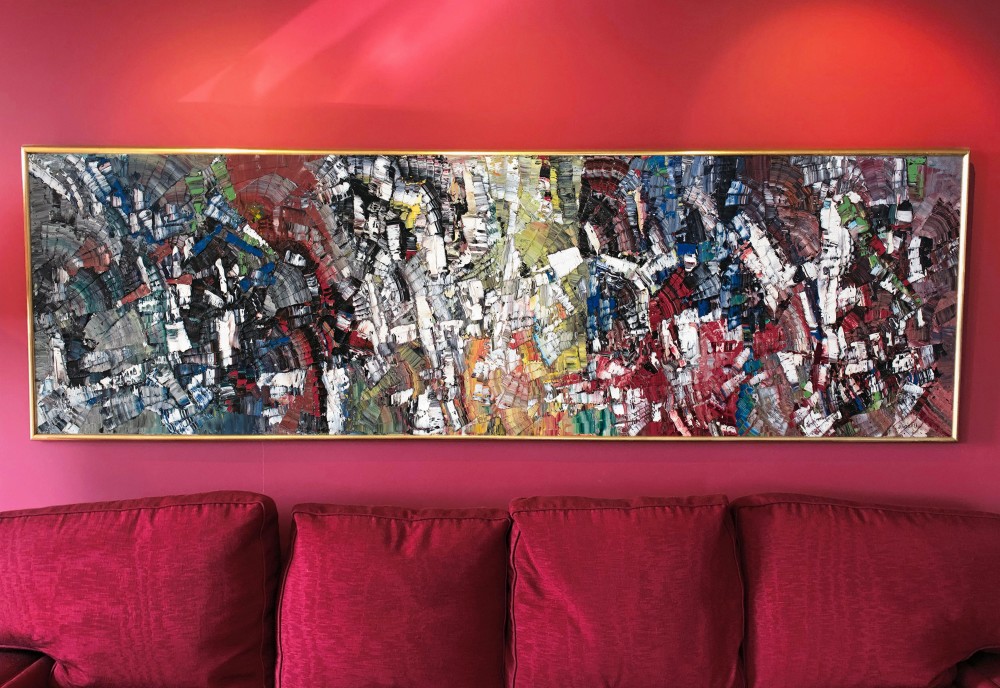Uncovering "Landing" by Jean Paul Riopelle
Landing is a dramatic canvas from the mid 1950s, the decade when Riopelle’s remarkable abilities reached their peak and were most widely admired. Even in his long and celebrated career – from his early years in Montréal as a prominent member of the influential avant-garde group ‘Les Automatistes’, as part of the Surrealist circle in France (the only Canadian to exhibit with this group in a landmark 1947 exhibition at the Galerie Maeght in Paris), then as a leading artist of French ‘Lyrical Abstraction,’ of ‘tachisme,’ ‘informel,’ and most generally, of the ‘Ecole de Paris,’ and finally to his later work in the north of Canada – it is still the work of the 1950s that defines Riopelle. His worldwide recognition included showing at the Bienal de São Paulo in 1951 and 1955, in the Younger European Painters exhibition at the Solomon R. Guggenheim Museum in 1953, and at the Venice Biennale in 1954 and 1962.
Landing is an especially dramatic painting that is part of a large group often referred to as ‘mosaics’ because of their bold, prismatic colour facets and effects on the eye. Riopelle’s signature style, this work embodied an expressive, unbridled freedom with roots in the ‘automatic’ (unconscious) tendencies of Surrealism. This painterly, expressive approach contrasted with the hard-edged, geometrical tendencies increasingly prevalent in both American colour field painting of the time and two generations of Montréal abstractionists known as the Plasticiens. In Landing, every slice of the palette knife into the abundant pigment Riopelle used, every application of colour and description of form, is purposeful yet also unplanned. Riopelle was physically and psychically immersed in making his paintings, working so fast that a blueprint could not be followed, and also working for very long stretches of time to get the results he wanted but could not anticipate except in the act of painting. For Riopelle, the risks of ruining the composition are present yet controlled: “I never begin a painting without having ready to hand all the colours I need,” he states [ 1 ].
What specifically does his impassioned technique yield in Landing? As with all the mosaic paintings, we should look at both intimate, close up passages of the surface and at its overall structure. Seen up close, Landing is in large part organized by vibrantly coloured, fan-like shapes, and what we might call its topography, the distinct three-dimensionality Riopelle built up with copious amounts of paint (see details). Characteristic of Riopelle’s technique, these forms are not monochromatic but instead show traces of adjacent colours in their predominant hue. For example, a largely grey ‘fan’ form will include tinctures of red and blue. These microstructures resolve into the architecture of the surface as a whole. Standing back from Landing, we readily perceive a sequence of loosely defined vertical bands. From left to right, we see a grey, blue, red, white, yellow, red, blue, white, and finally mauve strip or column of colour. Dynamic as Riopelle’s canvases always are, these areas do not stand still, nor are the colours in these zones more than predominantly blue, yellow, red, etc. There is no intimation of a sequence; instead, skeins of white pigment across the full canvas assert that we are seeing one surface without permanent boundaries.
Attention to two other aspects of Landing’s surface can yield a fuller appreciation of this painting’s compelling qualities. First, the overall working of the canvas enlivens it as a unified whole, but at the same time, a singular, primarily yellow top to-bottom-band very much centres the composition. Landing is also radically horizontal, much more so than most of Riopelle’s work, including a 1958 painting of the same title in the Musée d'art contemporain de Montréal. Perhaps the artist intuited that the 1956 painting would be more comprehensible and pleasing if it was balanced in this way. Both exciting and satisfying it certainly is.
Endnotes
1. Gilbert Érouart, Riopelle in Conversation, trans. Donald Winkler, Toronto: House of Anansi, 1995: 79.
---
Mark A. Cheetham, PhD, FRSC, is the author of books, volumes, and articles on topics ranging from Immanuel Kant and Art History to abstract art to Postmodernism in Canada. His two books on abstract art offer new understandings of this radical form over its 100+-year history (The Rhetoric of Purity: Essentialist Theory and the Advent of Abstract Painting; Abstract Art Against Autonomy: Infection, Resistance, andCure since the '60s.) Landscape into Eco Art: Articulations of Nature since the ‘60s was published in 2018. Active as a curator of contemporary and historical art, he recently presented Struck by Likening: The Power & Pleasure of Artworld Analogies at the McMaster University Museum of Art (2017). He is a professor of art history at the University of Toronto.






Add a comment